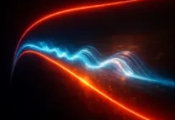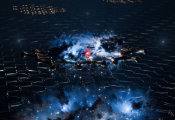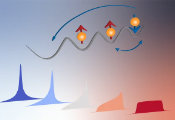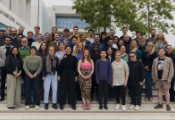‘Really Bizarre and Exciting’: The Quantum Oscillations Are Coming From Inside
October 30, 2025 -- As someone who studies materials, Lu Li knows people want to hear about the exciting new applications and technologies his discoveries could enable. Sometimes, though, what he finds is just too weird or extreme to have any immediate use.
Working with an international team of researchers, Li has made one of those latter types of discoveries, which the group detailed in the journal Physical Review Letters.
“I would love to claim that there’s a great application, but my work keeps pushing that dream further away,” said Li, professor of physics at the University of Michigan. “But what we’ve found is still really bizarre and exciting.”
The discovery was supported, in part, by the U.S. National Science Foundation and the U.S. Department of Energy and pertains to what are called quantum oscillations. These oscillations are found in metals and can be thought of as a phenomenon in which the metal’s electrons act like springs, Li said. By applying a magnetic field, researchers can change the speed with which those electron springs wiggle.
But, over the past several years, researchers have discovered the same quantum oscillations in insulators—nonmetals that don’t typically conduct heat or electricity. This led to a question that has stymied the field: Are those oscillations originating at only the surface of the material or is the behavior something that comes from within the material’s bulk?
From the standpoint of applications, the surface would be the more enthralling answer. Scientists are already exploring materials called topological insulators, which demonstrate metal-like behaviors at their surfaces while maintaining an insulator identity in their bulk, to enable new electronic, optical and quantum technologies.
But working with the world’s largest and most powerful magnet lab in the world, the National Magnetic Field Laboratory, Li and his colleagues have provided evidence that the quantum oscillations arise from the bulk.
“I wish I knew what to do with that, but at this stage we have no idea,” Li said. “What we have right now is experimental evidence of a remarkable phenomenon, we’ve recorded it and, hopefully, at some point, we’ll realize how to use it.”
The team included more than a dozen collaborators from six institutions in the U.S. and Japan. In addition to Li, the team included research fellow Kuan-Wen Chen and graduate students Yuan Zhu, Guoxin Zheng, Dechen Zhang, Aaron Chan and Kaila Jenkins from U-M.
“For years, scientists have pursued the answer to a fundamental question about the carrier origin in this exotic insulator: Is it from the bulk or the surface, intrinsic or extrinsic?” Chen said. “We are excited to provide clear evidence that it is bulk and intrinsic.”
Li likes to think of this work as exploring the frontiers of what he calls the “new duality.” In this context, the original or “old” duality came with the advent of quantum mechanics more than a century ago. During this time, scientists were showing that light and matter exhibit both particle and wave-like behaviors. This idea proved to be pivotal, not only in fundamental physics, but in developing technologies like solar cells and electron microscopes that are now commonplace.
To Li, the new duality is the ability of materials to behave as both conductors and insulators. To explore quantum oscillations in this context, his team used experiments with a material called ytterbium boride, or YbB12, inside a very strong magnetic field.
“Effectively, we’re showing that this naive picture where we envisioned a surface with good conduction that’s feasible to use in electronics is completely wrong,” Li said. “It’s the whole compound that behaves like a metal even though it’s an insulator. Unfortunately, this crazy metal behavior only occurs at 35 Tesla—a magnetic field strength that’s about 35 times what’s inside an MRI machine.”
So, while the applications may not be immediately obvious, there are no shortage of questions to ask about the behavior and how researchers might capitalize on it in less extreme conditions.
“Confirming that the oscillations are bulk and intrinsic is exciting,” Zhu said. “We don’t yet know what kind of neutral particles are responsible for the observation. We hope our findings motivate further experiments and theoretical work.”
Additional funding for the project was provided by the Institute for Complex Adaptive Matter, Gordon and Betty Moore Foundation, Japan Society for the Promotion of Science and Japan Science and Technology Agency.




































